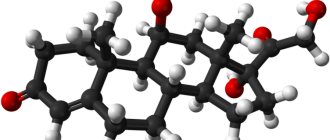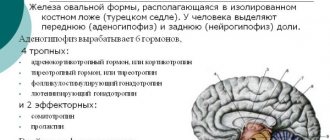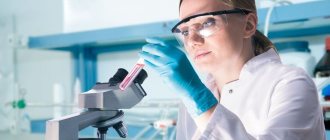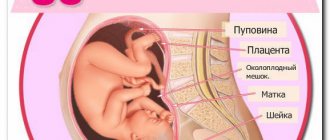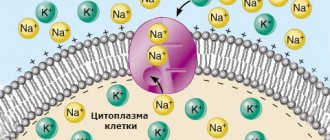Renin in the blood
– a biochemical indicator characterizing the concentration of a proteolytic enzyme in serum. This analysis has an independent diagnostic value, but is more often used in conjunction with the determination of aldosterone and angiotensin. Determination of renin activity in the blood is used to assess kidney function, in the treatment of hypertension, and also, if necessary, to regulate the water and electrolyte balance in the body. The test uses plasma isolated from the patient's blood. The unified method is chemiluminescent immunoassay. Normally, enzyme activity when collecting biomaterial in a lying position is 2.8-39.9 µIU/ml, and in a sitting or standing position – 4.4-46.1 µIU/ml. The test period is 1 business day.
Renin in the blood
– a biochemical indicator characterizing the concentration of a proteolytic enzyme in serum. This analysis has an independent diagnostic value, but is more often used in conjunction with the determination of aldosterone and angiotensin. Determination of renin activity in the blood is used to assess kidney function, in the treatment of hypertension, and also, if necessary, to regulate the water and electrolyte balance in the body. The test uses plasma isolated from the patient's blood. The unified method is chemiluminescent immunoassay. Normally, enzyme activity when collecting biomaterial in a lying position is 2.8-39.9 µIU/ml, and in a sitting or standing position – 4.4-46.1 µIU/ml. The test period is 1 business day.
Renin in the blood is a marker that determines the state of the renin-angiotensin system. The proteolytic enzyme is used to diagnose hypertensive conditions, as it is responsible for the regulation of blood pressure and water-salt homeostasis. Under the influence of renin, angiotensinogen is transformed into angiotensin-I, which, under the influence of angiotensin-converting enzyme (ACE), is converted into angiotensin-II. This vasoconstrictor affects the production and release of aldosterone from the adrenal cortex, a hormone that regulates the metabolism of potassium and sodium.
The active form of renin in the blood is synthesized in the periglomerular renal cells from prorenin. Enzyme production is increased with hyponatremia and decreased blood flow in the renal arteries. The activity of renin in the blood is subject to daily fluctuations, and also depends on the position of the patient’s body (higher in the vertical than in the horizontal). The analysis is widely used in clinical practice in therapy and endocrinology for the treatment of patients with hypertension, Addison's disease and Conn's syndrome.
What it is
An important element regulates water-salt homeostasis, blood pressure and the volume of blood circulating in the body. Proteolytic enzyme is one of the components of the renin-angiotensin system.
The renal component is produced by arterioles, specific cells in the bean-shaped organs. During the transformation process, renin is converted into the active vasoconstrictor substance angiotensin II, which affects the release of aldosterone (the hormone regulates sodium-potassium metabolism).
Renin secretion increases with decreased blood pressure and weaker blood flow. The production of a proteolytic enzyme is activated in a state of stress, with a decrease in blood supply to the renal ducts, against the background of a decrease in the volume of all circulating blood. With increased production of renin, sequential breakdown of liver protein occurs with the help of angiotensin I and II degrees. The consequence is a reduction in the muscle layer of large blood vessels, an increase in blood pressure, and activation of the secretion of the hormone aldosterone in the adrenal cortex.
The hormone renin-angiotensin or aldosterone-renin affects blood pressure levels: when blood pressure increases, hormones are released, and the levels gradually fall. Biochemical reactions lead to a narrowing of the lumen of the arteries, and blood pressure values again tend to rise.
Renin-angiotensin regulators are produced by the adrenal cortex. The analysis of renin and the ratio with aldosterone needs to be clarified in case of hypertension, the course of which is poorly affected by traditional antihypertensive drugs. Violation of the level of important elements indicates pathological processes in the kidneys or in the adrenal cortex. One of the reasons is kidney failure. Important to know: adrenal tumors increase renin production.
Find out what lactic acidosis is in type 2 diabetes and how to treat this dangerous complication.
Why is it formed and how to remove acetone in urine in diabetes? Read useful information at this address.
Renin research
Content:
- Renin research
- Features of the analysis
- Medical indications
- Causes of fluctuations in renin levels
- Schematic explanation
In the course of numerous studies, scientists have identified a pattern between the stimulation of the presented component and some associated factors. This is how it turned out to isolate a number of catalysts that induce renin to be released by the body.
Among them, the first place is the situation when potassium in the blood is increased or sodium is decreased. Also, the reason for starting the mechanism is a decrease in the standard volume of circulating blood or a sharp drop in blood pressure. Occasionally, the algorithm triggers insufficient blood supply to the “natural filter of the body.”
But any emotional overload, including accumulating stress, are indirect primary sources that can significantly aggravate the clinical picture.
The main task of renin is the ability to break down a special liver protein. In the course of complex chemical and biological reactions, the work performed by the enzyme leads to a reduction in the muscular layer of the arteries. The process ends with blood pressure jumping, and the release of aldosterone, for which the adrenal glands are responsible, begins to be produced with a vengeance.
Some people who receive the results of their tests are interested in the question of why, when assessing renin, laboratory assistants prescribe indicators for aldosterone. But the connection between these two components of the human body is proportional: the higher the level of the main enzyme, the more aldosterone units it gains.
The result of the development of an important element for the normal state of human health is expressed in:
- increased blood pressure;
- stabilization of sodium levels;
- normalization of water and potassium levels.
But all of the above is suitable for situations where the component is within standard boundaries. As soon as renin jumps sharply, the victim begins to complain of headaches and:
- muscle weakness;
- constipation;
- constant fatigue;
- frequent urination;
- arrhythmia.
And if you take pressure measurements at this time, the arterial indicator will be an order of magnitude higher than the average value.
In the reverse process, when there is not enough enzyme, the victim will suffer from low blood pressure, seizures and even impaired consciousness. Arrhythmia persists in both clinical cases.
To identify specific reasons for increased readings or other changes, experts strongly recommend using one of two types of diagnostics for renin levels:
- direct definition;
- activity in blood plasma.
The first point involves testing the RENP format or mass concentration.
Role in the body
The main functions of the proteolytic kidney enzyme are:
- regulation of the volume of blood circulating through the vessels,
- maintains an optimal balance of water, sodium and potassium in the body,
- control of blood pressure indicators.
Excessive intake of renin into the blood is just as dangerous as a low concentration of prohormone. Long-term deviation of the regulator level from the norm provokes the development of severe chronic diseases. The kidneys and elements of the cardiovascular system experience the greatest negative impact.
Increased level
– this is the name of the state of the body when aldosterone is increased as a result of its active production by the adrenal glands.
Causes:
- Conn's syndrome – primary hyperaldosteronism. In this case, excess hormone is produced due to a benign tumor of the adrenal cortex;
- pregnancy – during gestation the level increases, after the birth of the child it quickly returns to normal;
- cirrhosis of the liver and other liver diseases - with these pathologies, the level of aldosterone increases only in women;
- disorders of the cardiovascular system - most often, heart failure and high blood pressure lead to an increase.
Normal prohormone levels
Optimal levels of proteolytic enzyme in blood plasma:
- vertical position of the patient from 0.7 to 2.6 mg/l/hour,
- horizontal position during analysis from 0.5 to 2 mg/l/hour.
Acceptable level of proteolytic enzyme activity in blood plasma:
- from 3.3 to 41 µU/ml,
- from 0.29 to 3.7 ng/(ml*hour).
On a note! To assess the level of renin, doctors use two methods: the activity of the proteolytic enzyme in the blood plasma or the direct determination of prohormone indicators (mass concentration or RENP).
Hormone levels in the blood
The renin level is the same in women and men. Fluctuations in its quantity depend on the position of the patient’s body during the test. When a person lies down, the cardiovascular system functions more slowly, so the blood transports the hormone at a slower rate. In an upright position, the heart rate is higher, blood flows faster and normal values change.
Renin level in blood:
- in a horizontal position of the body 0.5-2 mg/l per hour;
- in a vertical position of the body 0.7-2.5 mg/l per hour.
Important! When changing body position while donating blood, it is necessary that 20-30 minutes pass after this action to donate blood. Otherwise the result will not be correct
The normal level of renin activity in the blood of a healthy person ranges from 0.3 to 3.5 ng/ml per hour.
Since in pregnant women the amount of the hormone can increase 4 times, this indicator is taken into account only when symptoms of renal pathology appear. . The norm values and research method in different laboratories may differ and are indicated on the analysis form
The norm values and research method in different laboratories may differ and are indicated on the analysis form.
High levels of renin in the blood
An increase in the concentration of a substance per liter of blood (renin level in the blood) indicates the emergence of a pathological condition that needs to be treated or a temporary physiological change that will pass over time.
- A decrease in the amount of blood caused by a decrease in body fluid volume (vomiting, diarrhea, dehydration).
- A decrease in the volume of plasma inside the vessels due to the transfer of fluid to the organs. Swelling of the extremities appears (because of this, a large amount of fluid is retained), kidney pathologies with increased release of fluid from the body.
- A decrease in pressure only in the kidneys, or in the entire body as a whole, which leads to activation of the renin-angiotensin-aldosterone system, an increase in hormone levels, and an increase in pressure.
- Cysts in the kidneys, due to which inflammation of the tissue occurs and fluid is retained.
- Increased blood pressure, leading to the removal of trace elements from the body. Their loss causes plasma renin to rise to restore balance.
- Impaired functioning of the site of angiotensinogen release (inflammation of the glomeruli, called glomerulonephritis).
- Benign or malignant neoplasm of the kidneys with the production of some hormone above normal limits.
- Adrenal tumor. Diseases that lead to the growth of its tissue.
- Impaired absorption in the glomeruli of the kidneys and damage to the nephrons.
- Thyroid disorder. This may be its inflammation, leading to hyperfunction. Other endocrine disorders of the endocrine glands.
- Heart failure, a disease associated with the inability of the organ to pump blood in full and deliver hormones to its destination.
- Taking certain medications that activate the hormone.
- Addison's disease.
- Diseases of the pituitary gland that cause increased levels.
Causes and symptoms of deviations
Renin activity is influenced by many factors: diseases, medications, patient condition, unbalanced diet. When developing a scheme for correcting deviations, it is necessary to find out the factor that causes changes in the level of the proteolytic enzyme.
Decrease in renin levels reasons:
- excessive secretion of the antidiuretic hormone vasopressin,
- Crohn's syndrome. The patient was diagnosed with an adrenal adenoma that produces aldosterone,
- excess salt intake into the body,
- deficiency of potassium in the diet,
- development of acute renal failure.
Symptoms:
- blood pressure drop,
- heart rhythm disturbances,
- convulsive syndrome,
- loss of consciousness.
Increased renin levels provoking factors:
- insufficient fluid intake into the body,
- Addison's disease, which causes hypofunction of the adrenal glands,
- development of a malignant tumor in nerve cells or blood vessels of neuroblastoma or hemangiopericytoma,
- the lumen in the important renal artery is narrowed,
- cirrhosis of the liver,
- insufficient intake of sodium salts from food,
- pathological changes in the kidneys, causing a sharp decrease in protein levels and increased swelling,
- cancer of the bean-shaped organs: a malignant tumor produces renin,
- violation of the structure and functions of the right ventricle, improper blood circulation,
- arterial hypertension,
- taking medications: corticosteroids, diuretics, estrogens, prostaglandins, Hydralazine and Diazoxide.
Symptoms:
- blood pressure rises,
- arrhythmia develops
- urination becomes more frequent.
How and where is it produced?
Renin is produced in the renal arterioles. A protein produced in the kidneys is converted through complex chemical reactions into renin.
The formation of the hormone occurs as a result of:
- lowering blood pressure;
- occurrence of a stressful situation;
- reducing salt in the urine, potassium or sodium in the blood;
- reducing the amount of circulating blood;
- insufficient blood supply to the kidney ducts.
Indications for testing for renin, angiotensin and aldosterone
The study of a complex of hormones is prescribed for pathological conditions:
- development of hypertension in young people,
- standard antihypertensive drugs do not reduce high blood pressure,
- medications prescribed: Reserpine, Propanolol, Indomethacin, Clonidine,
- tests show potassium deficiency in the blood,
- a tumor has been detected in the adrenal glands or kidneys,
- diagnostics when identifying signs of primary hyperaldosteronism,
- blood pressure readings are consistently low,
- During a computed tomography scan or a more informative MRI study, a narrowing of the lumen of the renal artery was detected.
How to prepare for analysis
To study the state of the renin-angiotensin-aldosterone system, a venous blood test is prescribed. Based on the results of the analysis, it is possible to identify the level of renin, aldosterone and the ratio of regulators.
Preparation for the test begins 1430 days in advance. It is important to know: if you do not follow a diet, take certain medications, or be exposed to external factors, inaccurate results are possible.
Memo for the patient:
- for two to four weeks, receive no more than 3 g of table salt per day, consume foods with potassium (dried apricots, potatoes, bananas) as usual,
- before the study you should not be nervous, play sports, do hard work,
- Be sure to give up alcohol for several days. If hypertension develops, you should not drink alcohol: severe complications and hypertensive crisis are possible,
- you should not smoke several hours before blood sampling,
- analysis for renin and aldosterone is taken in the morning, on an empty stomach,
- The position for blood sampling is determined by the laboratory assistant (as directed by the doctor).
Renin is a specific kidney substance, the level of which depends not only on the time of day when the patient donates the biomaterial, but also on the position of the person: the indicators when taking the biomaterial while standing and lying down will differ.
Look at the list of antiandrogenic drugs for women against hirsutism and find out the features of their use.
Useful recommendations from endocrinologists on the prevention of type 2 diabetes are collected in this article.On the page https://fr-dc.ru/vnutrennaja-sekretsija/shhitovidnaya/follikulyarnaya-adenoma.html read about the symptoms and treatment of follicular adenoma of the thyroid gland.
Causes of fluctuations in renin levels
For a healthy person, the result of plasma renin activity, called PRA testing, is 0.29-3.7 ng/(ml*hour). Don't worry if the boundaries include fluctuations of 3.3-41 µU/ml.
If we are talking about RENP, then it is worth taking into account the position of the patient in space at the time of collection of biological material. If the action took place in a horizontal position, then the healthy radius will cover values from 0.5 to 2.0 mg/l/hour. With a vertical position, the bar rises slightly to 0.7-2.6 mg/l/hour.
When the doctor reviews the results of his patient, he will definitely take into account the information that other tests provided. We are talking about a general examination of blood, urine, liver and kidney tests.
If you suspect a serious deviation, it is most effective to go for related tests such as ionography and osmolarity. Some diseases can be identified if, together with the main analysis, you also check ACTH and cortisol, as well as evaluate antidiuretic hormone.
Much less often, experts choose the following methods as additional tools to help determine the disease and its source:
- glomerular filtration rate test;
- accounting for total protein;
- albumin and aldosterone levels.
But sometimes, even after a comprehensive detailed examination, it is not possible to identify the primary source of abnormal renin levels. Then the doctor will look for reasons for its jumps in environmental factors.
Thus, it has long been proven that inflated numbers are characteristic of people who are experiencing stress or have been exposed to significant physical activity.
The following can also bias the results:
- low salt diet;
- abuse;
- taking laxative medications;
- use of medications that contain lithium.
Conventional diuretic blockers of a certain type and opiates can also blur the clinical picture.
Women need to be especially vigilant, since renin usually doubles in the first few months of pregnancy. Upon reaching the twentieth week, the enzyme generally becomes four times more than in ordinary people. A similar physiological temporary anomaly occurs due to increased secretion of aldosterone, as well as an increased volume of fluid accumulating in the body.
Among the nuances that work in the opposite order, note the presence of excessive amounts of androgens. This is what male sex hormones are called in professional terminology.
Antidiuretic hormone medications, corticosteroids, beta blockers, and calcium channel blockers work in a similar way. Even excessive consumption of licorice leads to too much renin accumulation in the body.
Renin and the development of hypertension
When the level of proteolytic enzyme increases, blood flow increases and the passage of circulating fluid through the kidneys increases. Prolonged stress above normal on the thinnest membranes can lead to rupture of sensitive structures. When nephrons are damaged or the water-salt balance is disturbed, the ratio of potassium and sodium changes, edema appears, the load on the blood vessels and heart increases, and it is difficult to return the pressure to optimal levels.
The level of renin changes when blood vessels narrow, and the body tries to compensate for the deficiency of the proteolytic enzyme, which leads to a further increase in renin levels, blood pressure, and increased secretion of aldosterone. Breaking the vicious circle and eliminating the pathological process is possible only with a comprehensive approach to therapy.
Age-related vasoconstriction with the accumulation of harmful cholesterol and a decrease in the elasticity of the vascular wall negatively affects the stability of blood pressure. It is no coincidence that after 45 years, many people experience manifestations of arterial hypertension, against the background of which, with a combination of provoking factors, a hypertensive crisis can develop. The risk of hypertension increases with extra pounds, physical inactivity, and high glucose concentrations in the body.
Heart failure often develops against the background of hypertension. A sharp increase in the volume of blood circulating in the body, combined with increased blood pressure, wears out the heart muscle. If the level of renin is disturbed, muscle fibers weaken, shortness of breath appears even with minimal exertion, arrhythmia develops, and the mucous membranes become inflamed. Swelling of various parts of the body is one of the signs of heart failure. With an excess of proteolytic enzyme, not only the heart suffers, but also the liver, kidneys, and adrenal cortex.
Treatment of hyperaldosteronism
If there is an increase in aldosterone levels caused by an adenoma, removal of the adrenal gland is indicated. In this case, the patient recovers completely. If it is idiopathic adrenal hyperplasia, then removing the adrenal glands does not help. In this case, the drug veroshpiron is used. It is a potassium-sparing diuretic by reducing the synthesis of aldosterone by the adrenal glands. It is prescribed at a dose of 200-400 mg per day. May be prescribed in combination with other drugs that lower blood pressure.
Treatment of secondary hyperaldosteronism involves eliminating the underlying cause of elevated aldosterone.
With warmth and care, endocrinologist Dilyara Lebedeva
